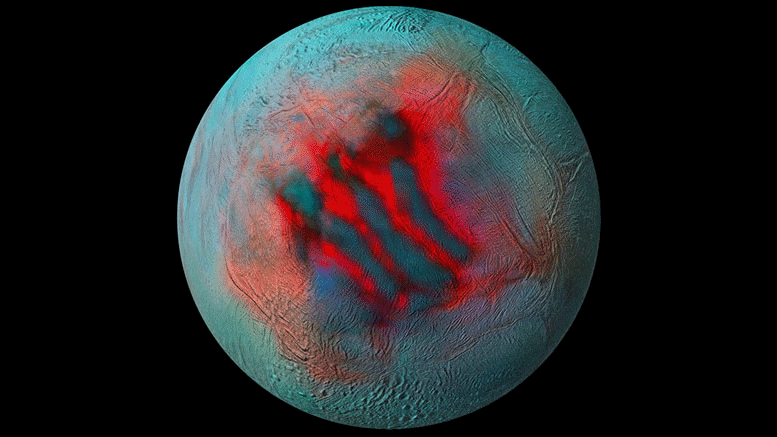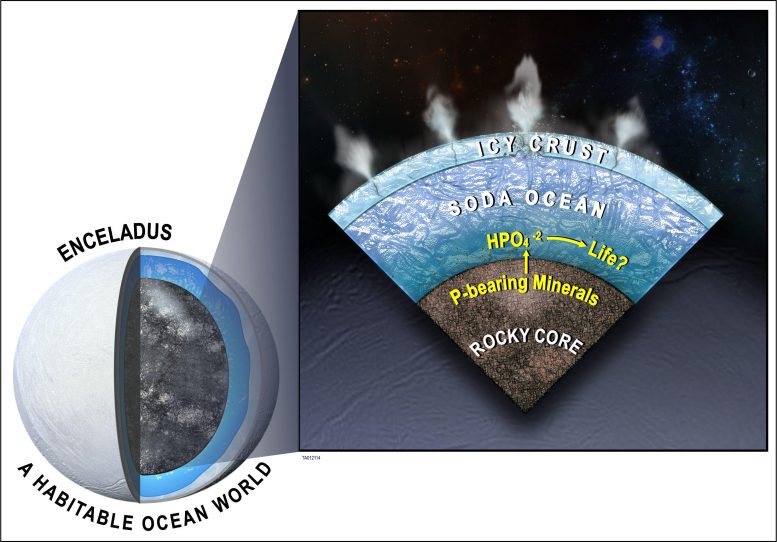
The subsurface ocean of Saturn’s moon is most likely rich in phosphorus, a key component for life.
The hunt for extraterrestrial life has just become more intriguing as a group of researchers led by Dr. Christopher Glein of the Southwest Research Institute found new evidence of a key building block for life in the subsurface ocean of Saturn’s moon Enceladus. According to new modeling, Enceladus’ ocean should be quite rich in dissolved phosphorus, a crucial ingredient for life.
“Enceladus is one of the prime targets in humanity’s search for life in our solar system,” said Glein, a leading expert in extraterrestrial oceanography. He is a co-author of a paper recently published in the journal Proceedings of the National Academy of Sciences (PNAS) describing this research. “In the years since NASA’s Cassini spacecraft visited the Saturn system, we have been repeatedly blown away by the discoveries made possible by the collected data.”

The Cassini mission detected and analyzed samples of Enceladus’ underlying liquid water when plumes of ice grains and water vapor burst into space from cracks in the moon’s icy surface.
The Significance of Phosphorus in the Search for Life
“What we have learned is that the plume contains almost all the basic requirements of life as we know it,” Glein said. “While the bioessential element phosphorus has yet to be identified directly, our team discovered evidence for its availability in the ocean beneath the moon’s icy crust.”
One of the most significant findings in planetary science in the last 25 years is that worlds with oceans under an ice surface layer are common in our solar system. The icy satellites of the large planets, including Europa, Titan, and Enceladus, as well as more distant entities like Pluto, are examples of such worlds. Worlds with surface seas, like Earth, must stay within a narrow range of distances from their host stars in order to maintain temperatures suitable for surface liquid water. Interior water ocean worlds, on the other hand, may occur across far greater distances, substantially increasing the number of habitable worlds that are predicted to exist throughout the galaxy.
“The quest for extraterrestrial habitability in the solar system has shifted focus, as we now look for the building blocks for life, including organic molecules, ammonia, sulfur-bearing compounds as well as the chemical energy needed to support life,” Glein said. “Phosphorus presents an interesting case because previous work suggested that it might be scarce in the ocean of Enceladus, which would dim the prospects for life.”
Phosphorus in the form of phosphates is vital for all life on Earth. It is essential for the creation of DNA and RNA, energy-carrying molecules, cell membranes, bones, and teeth in people and animals, and even the sea’s microbiome of plankton.
New Geochemical Modeling
Team members performed thermodynamic and kinetic modeling that simulates the geochemistry of phosphorus based on insights from Cassini about the ocean-seafloor system on Enceladus. In the course of their research, they developed the most detailed geochemical model to date of how seafloor minerals dissolve into Enceladus’s ocean and predicted that phosphate minerals would be unusually soluble there.
“The underlying geochemistry has an elegant simplicity that makes the presence of dissolved phosphorus inevitable, reaching levels close to or even higher than those in modern Earth seawater,” Glein said. “What this means for astrobiology is that we can be more confident than before that the ocean of Enceladus is habitable.”
According to Glein, the next step is clear: “We need to get back to Enceladus to see if a habitable ocean is actually inhabited.”
Reference: “Abundant phosphorus expected for possible life in Enceladus’s ocean” by Jihua Hao, Christopher R. Glein, Fang Huang, Nathan Yee, David C. Catling, Frank Postberg, Jon K. Hillier and Robert M. Hazen, 19 September 2022, Proceedings of the National Academy of Sciences.
DOI: 10.1073/pnas.2201388119
Never miss a breakthrough: Join the SciTechDaily newsletter.
3 Comments
So…your saying that theres a possibility of us finding a life on a moon of other planet? If that so, are you all thinking to move in space and find a moon? 🌚
Let me translate this. “Having had no luck finding life on Mars and no clue how it could have started on earth, we want more of your money so we can explore the sunless, freezing cold underground water on Saturn’s moons. We know very well there’s not snowball’s chance of finding it, but if we can drum up enough false hope, we can save our jobs
Whether there’s life or no life on any of those planets, moons or exo-planets. At least we’re still looking! I love that I’m not the only one suspended on the edge of my chair everytime I read about NASA! I hope we just figure out a way we can explore and skip these hypotheses and see something we have never dreamed of seeing!
Let’s hope they are friendly. Because what’s been told about our people’s on earth and extraterrestrials and how we deal with them, let’s hope they don’t do worse!